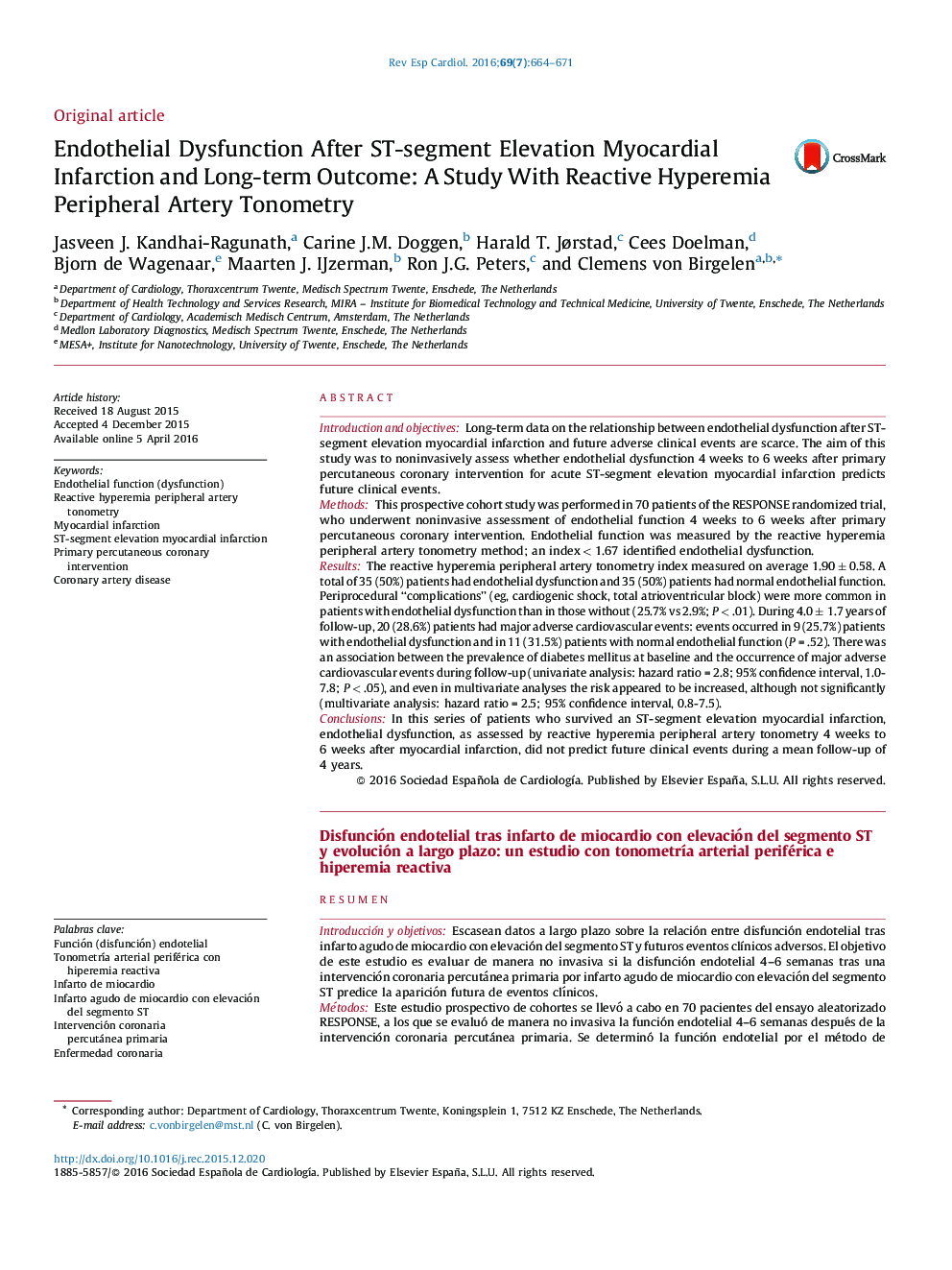| Article ID | Journal | Published Year | Pages | File Type |
|---|---|---|---|---|
| 3016101 | Revista Española de Cardiología (English Edition) | 2016 | 8 Pages |
Introduction and objectivesLong-term data on the relationship between endothelial dysfunction after ST-segment elevation myocardial infarction and future adverse clinical events are scarce. The aim of this study was to noninvasively assess whether endothelial dysfunction 4 weeks to 6 weeks after primary percutaneous coronary intervention for acute ST-segment elevation myocardial infarction predicts future clinical events.MethodsThis prospective cohort study was performed in 70 patients of the RESPONSE randomized trial, who underwent noninvasive assessment of endothelial function 4 weeks to 6 weeks after primary percutaneous coronary intervention. Endothelial function was measured by the reactive hyperemia peripheral artery tonometry method; an index < 1.67 identified endothelial dysfunction.ResultsThe reactive hyperemia peripheral artery tonometry index measured on average 1.90 ± 0.58. A total of 35 (50%) patients had endothelial dysfunction and 35 (50%) patients had normal endothelial function. Periprocedural “complications” (eg, cardiogenic shock, total atrioventricular block) were more common in patients with endothelial dysfunction than in those without (25.7% vs 2.9%; P < .01). During 4.0 ± 1.7 years of follow-up, 20 (28.6%) patients had major adverse cardiovascular events: events occurred in 9 (25.7%) patients with endothelial dysfunction and in 11 (31.5%) patients with normal endothelial function (P = .52). There was an association between the prevalence of diabetes mellitus at baseline and the occurrence of major adverse cardiovascular events during follow-up (univariate analysis: hazard ratio = 2.8; 95% confidence interval, 1.0-7.8; P < .05), and even in multivariate analyses the risk appeared to be increased, although not significantly (multivariate analysis: hazard ratio = 2.5; 95% confidence interval, 0.8-7.5).ConclusionsIn this series of patients who survived an ST-segment elevation myocardial infarction, endothelial dysfunction, as assessed by reactive hyperemia peripheral artery tonometry 4 weeks to 6 weeks after myocardial infarction, did not predict future clinical events during a mean follow-up of 4 years.
ResumenIntroducción y objetivosEscasean datos a largo plazo sobre la relación entre disfunción endotelial tras infarto agudo de miocardio con elevación del segmento ST y futuros eventos clínicos adversos. El objetivo de este estudio es evaluar de manera no invasiva si la disfunción endotelial 4–6 semanas tras una intervención coronaria percutánea primaria por infarto agudo de miocardio con elevación del segmento ST predice la aparición futura de eventos clínicos.MétodosEste estudio prospectivo de cohortes se llevó a cabo en 70 pacientes del ensayo aleatorizado RESPONSE, a los que se evaluó de manera no invasiva la función endotelial 4–6 semanas después de la intervención coronaria percutánea primaria. Se determinó la función endotelial por el método de tonometría arterial periférica con hiperemia reactiva; la disfunción endotelial se identificó por un índice < 1,67.ResultadosEl índice de tonometría arterial periférica con hiperemia reactiva fue en promedio 1,90 ± 0,58. Un total de 35 (50%) pacientes presentaban disfunción endotelial y 35 (50%) tenían función endotelial normal. Las «complicaciones» periintervención (como shock cardiogénico o bloqueo auriculoventricular completo) fueron más frecuentes entre los pacientes con disfunción endotelial que entre quienes no la presentaban (el 25,7 frente al 2,9%; p < 0,01). Durante un seguimiento medio de 4,0 ± 1,7 años, 20 pacientes (28,6%) presentaron eventos adversos cardiovasculares mayores: se produjeron eventos de este tipo en 9 pacientes (25,7%) con disfunción endotelial y 11 (31,5%) con función endotelial normal (p = 0,52). Se observó asociación entre la prevalencia basal de diabetes mellitus y la aparición de eventos adversos cardiovasculares mayores durante el seguimiento (análisis univariable, hazard ratio = 2,8; intervalo de confianza del 95%, 1,0-7,8; p < 0,05) e incluso en los análisis multivariable el riesgo parecía aumentar, aunque sin alcanzar significación estadística (análisis multivariable, hazard ratio = 2,5; intervalo de confianza del 95%, 0,8-7,5).ConclusionesEn esta serie de pacientes que habían sobrevivido a un infarto agudo de miocardio con elevación del segmento ST, la disfunción endotelial evaluada mediante tonometría arterial periférica con hiperemia reactiva 4–6 semanas tras el infarto de miocardio, no predijo los eventos clínicos futuros en una media de seguimiento de 4 años.
